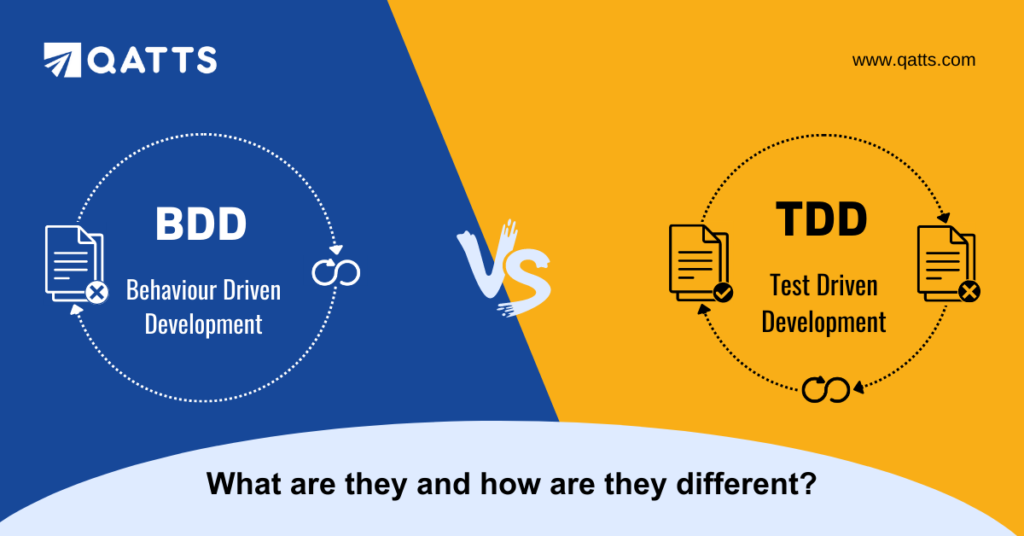
As software development keeps on getting more and more advanced, new techniques keep springing up, making the entire process more agile. There are a number of processes and techniques involved in software development, with all of them seemingly the same on a surface level, but really unique when properly understood. Two of such processes are BDD and TDD – Behaviour Driven Development and Test Driven Development.
In this blog, we shall look at the differences between BDD and TDD, and why they are used, and in which instances.
What is Behaviour Driven Development (BDD)?
BDD – Behaviour Driven Development is a software development technique where the test behaviour is written first. The code required for the application to perform that behaviour is then written.
BDD is mostly employed in automation testing and is the best practice in automation testing as it focuses on the behaviour of the application, and enables easy collaboration between developers, testers and business users.
What is the process of Behaviour Driven Development (BDD)?
There are six crucial steps that are involved in the process of BDD. The following are those steps:
- Writing the behaviour of the application
The product or business owner, or QAs write down the behaviour of the application in simple English, thus defining how the application should behave. - Writing automated scripts
Depending upon how the application should behave, programming test codes are then written. - Implementing functional code
The functional code underlying the behaviour of the application is then implemented and is checked whether it is performing the way it is supposed to. - Checking for the behaviour’s success
The behaviour should be checked for success. If the behaviour is successful, then you can move on to implement the next behaviour. If it is unsuccessful, then the errors should be fixed to achieve the required behaviour. - Organizing the code
Reorganise or organise your code to make it more readable and re-usable. This will make future use of the code easier. - Repeating for new behaviour
The steps that have been implemented in executing the required behaviour successfully, should be repeated for more behaviours.
Best Practices for Behaviour Driven Development (BDD)
It can get confusing when trying to understand which the best practices are, to employ for BDD. Here’s a list of the best practices for BDD:
- Avoid lengthy descriptions
Any feature description should be short and sweet, as lengthy descriptions usually become boring to read for stakeholders. Thus, descriptions should always be short. - Stick to a single format
Whatever format you may choose to write your feature in, in behaviour driven development, it is advisable to stick to this format throughout. This will make it easy for anyone who is new to the project to understand it easily and faster as well. - Short background
Using a background for shared steps that are required for each scenario in your file will help rid repetitive steps and help you avoid duplication as well. Keeping the background short will also help give a quick understanding for every scenario. - Non-technical language in background
When writing the background, avoid using technical language, as it would make the background confusing to understand. - Scenario or scenario outline
Single examples and multiple examples can be dealt with Gherkin, with the means of a scenario or a scenario outline, respectively.
For any particular scenario, if you have more than one example, then you can use scenario outline to cover multiple examples. If you just have a single example, then use scenario. This will help make the scenarios a lot more readable and will prevent you from duplicating steps. - Short scenarios
As is the case with background, it is important to keep your scenario descriptions short, as long and descriptive scenarios can get confusing and less readable. Thus, keep your scenarios short. - Use the Given-When-Then formula correctly
Use the right sequence of the Given-When-Then formula, when writing scenarios. This helps making the implementation easy and also the understanding.
Here’s the proper usage of the formula:- Given [some context]
- When [some action or event occurs]
- Then [some outcome occurs]
What is Test Driven Development (TDD)?
TDD – Test Driven Development is a software development technique that focuses more on implementing a feature of a software application or product. In this method, a test case is written, which is bound to fail, because the specified functionality doesn’t exist. Following that update, the code can make the test case pass, thus implementing the feature in the system. In this process, the developers are involved.
What is the process of Test-Driven Development (TDD)?
There are six crucial steps that are involved in the process of Test-Driven Development. The following are those steps:
- Writing a test case
Write an automated test case based on the requirements. - Running all the test cases
On the currently developed code, run these automated test cases - Developing code for test cases
If your test cases work, that’s perfect. If the test cases do not work, then write a code that would ensure your test case would work as expected. - Re-running test cases
Re-run all the test cases that have been developed so far to make sure that every test case works exactly the way it is supposed to. - Refactoring code
While refactoring your code is an optional step, refactoring your test cases will help your code be more readable and reusable. - Repeat
Until all the test cases are completed and implemented, you should repeat the above steps to achieve the desired results.
Best Practices for Test-Driven Development (TDD):
It can get confusing when trying to understand which the best practices are, to employ for BDD. Here’s a list of the best practices for TDD:
- Write tests before code
First, the expected behaviour of a new feature or a bug fix is to be described, which can be done by writing a test that fails. Ensure that this test fails before you get to the next step. - Write the minimum code to pass the test
No extra functionality should be added at this stage, and only the simplest code that makes the failing test pass should be written. - Refactor the code
After the test has passed, any potential improvements necessary can be made. These improvements can include optimizing the performance, simplifying the logic, or adhering to coding standards. - Repeat the process for each new feature or bug fix
The above process is to be repeated for every new feature or bug fix. - Run your tests frequently
To ensure that code changes do not break the existing functionality, you should regularly run tests. This also helps catch regressions at an early stage. - Continuous Integration (CI)
When incorporated into a CI pipeline, your tests are automated, and the CI system will automatically build the application, run the tests and report the results. Your application thus remains in a releasable state and every element is thoroughly tested.
What Are The Benefits Of BDD And TDD?
The BDD and TDD frameworks offer a number of advantages in automation testing. The benefits of BDD and TDD in testing include the following scenarios:
| S.No. | Criteria | BDD | TDD |
| 1. | Test Coverage | Low | High |
| 2. | Code reusability | High | Low – because the code might differ every single time |
| 3. | Code methodology | The behaviour of the software is defined first, according to which the code is written | First, the code is written, and then changes are made according to requirements |
| 4. | Functionality | Code can be easily reused for various cases | Additional features can be easily added to the code |
| 5. | Rework | Less | High |
Here are a few other benefits of BDD:
- Clarity of Scenarios
By virtue of simple language being used to write the necessary behaviour for the application or product, even automated tests turn out to be easy to understand for non-technical people. This helps make the process much easier and enables it to stay focused on the product behaviour. - Scope for rapid Iterations
Rapid iterations can be made based on any and all feedback that is received from the users, based on their necessity. - Parameterization in Feature File
The gherkin steps in a feature file can be parameterised to obtain reusability in the file. This helps reduce a lot of work and time for the user and the developer/tester as well.
Here are a few other benefits of TDD:
- Improved code quality
There wouldn’t be any unnecessary code present, as every piece of code is written to make the test in place pass. As such, your code is clean and optimised without anything that’s unnecessary or extra. - Code is easy to understand
BDD and TDD have this in common, where the code is written in simple, understandable language. As a result, the code is easily understood by anyone – even non-technical people working on the project. - Code design is better
The code written in TDD is well structured, which makes it easier to pass, modify, extend, test and maintain. This also means that a lot of effort does not need to be put in to pass any modification or updates.
Behaviour Driven Development (BDD) Vs Test-Driven Development (TDD) : Key Differences
BDD and TDD have their own share of differences at the core level, which need to be understood properly, to be to perform the functions appropriately. Here’s a look at the key differences between BDD and TDD:
| S.NO. | Parameter | Behaviour Driven Development | Test Driven Development |
| 1. | Emphasis | Behaviour driven development puts more emphasis on the behaviour of a software programme. | Using the test-driven development methodology, a software application’s or product’s execution of a feature is given more attention. |
| 2. | Personnel involved | In BDD, Developers, Customer and QAs take part. | Only developers take part in TDD. |
| 3. | Process | This process primarily involves creating an executable specification that fails because the necessary feature isn’t present, followed by writing the simplest possible code to enable the specification to succeed and, as a result, implementing the desired behaviour in the system. | It mainly involves writing a test case that fails because the desired functionality isn’t present, updating the code to make the test case succeed, and then adding there desired functionality to the system. |
| 4. | Focus | The main focus is on system requirements. | The main focus is on unit test. |
| 5. | Starting point | Here, the starting point is a scenario. | Here, the starting point is a test case. |
| 6. | Type | It is a team methodology. | It is a development practice. |
| 7. | Language used | Only simple English is used to write the required behaviour | Programming language is used for feature development. |
| 8. | Collaboration | BDD enables collaboration between all the stakeholders. | In TDD, collaboration is only between the developers. |
| 9. | Suitability | Perfect for project development, It is a good approach for project development which are driven by user actions. | It is a good approach for projects which involve API and third-party tools. |
| 10. | Tools used | Some of the tools used are Cucumber, Dave, JBehave, Spec Flow, Concordian, BeanSpec etc. | Some of the tools used are JBehave, JDave, Cucumber, Spec Flow, BeanSpec, FitNesse etc. |
Conclusion
Behaviour Driven Development and Test Driven Development have their own functions and needs. While both might seem similar on a very surface level, they are very unique and have their own merits. Depending on the requirement of the application being worked upon, either BDD or TDD is selected, also depending upon the flexibility of those working on it.


